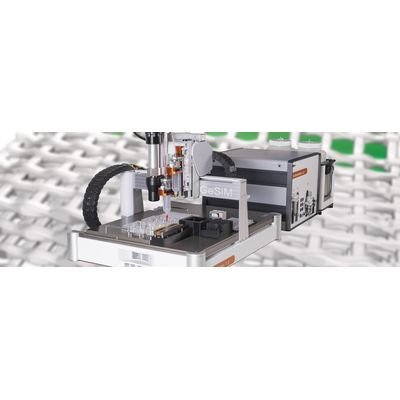

- Home
- Companies
- GeSiM - Gesellschaft fur ...
- Products
- BioScaffold - Versatile Bioprinters

BioScaffold - Versatile Bioprinters
Additive manufacturing (AM) for tissue engineering (TE) and regenerative medicine combines biocompatible/biodegradable polymers with living cells. GeSiM 3D bioprinters can create bioscaffolds for cell growth or deposit layers of bioinks on implants or microfluidic objects. However, artificial bones, skin, organoids still not reach their originals made by nature. Research on this subject requires flexible lab equipment, compatible even with new tools and accessories still to be developed.
Our bioprinters offer this level of versatility. Pneumatic extrusion is on board of each GeSiM bioprinter, numerous tools can be configured with your order or added years later. The user interface fits into this philosophy and adapts to each individual combination of tools.
Most extrusion tools fit to all GeSiM instruments. The combination of 3D printed scaffolds with Nanolitre pipetting and microfluidics extends the field of TE to drug discovery, cell biology and more.
Applications at a Glance:
- 3D Printing of very different (Bio-)polymers (can contain cells)
- Design and print of porous – multi material – structures for tissue engineering
- Co-printing of hard (E.g. PCL/PLA) and soft (E.g. Alginate) biopolymers (Sequential printing, co-axial extrusion, Nanolitre pipetting)
- Functionalization of metal implants with soft polymer layers
- Printing of micro structures from biopolymers by melt electro spinning/writing
- Co-printing of two polymer melts through a gradient mixer
Smart Technology for Efficient Use
- Silent but smart XYZ-drives with Micrometer precision, individually Z-axes for print tools and optical components
- Decentralized units for printing, media control and computing save your precious space in biosafety cabinets and ensure superb heat dissipation
- Same software for all GeSiM bioprinters with easy to use CAD import
- UV-light sources of different intensity/ costs on the print head; camera systems
- Standard plastic cartridges as well as all Luer- lock nozzles can be used on all GeSiM bioprinters for 3d prints at room temperature
- Automatic alignment of all nozzle sizes to the building platform
- Print beds for SBS well plates with easy click fixation, temperature control and customized layouts available on request
Nanolitre Pipetting
Tissue Engineering often raises interface and surface questions: How do cells adhere to artificial bones, implants and similar objects? What is the optimum scaffold geometry/ scaffold material to achieve appropriated cell adherence? Which cell line works, which doesn’t? Just throwing your ready-printed 3D object into a petri dish with cell suspension? – The Nanolitre pipetting module applies cells with spatial resolution during printing. Design and realization of complex artificial tissue with several cell types – partially applied to different parts of your 3D structure – becomes feasible.
The GeSiM Nanolitre Pipetting module allows up to 96 different cell suspensions or protein solutions for embedding into 3D structures during printing.
- CAD – based tethering of cells/proteins to parts of a 3D structure during printing,
- Volumes <100 Microlitres per species save resources when using rare and expensive samples,
- Onboard washing allows subsequent liquid handling of different species with one tool,
- Dispense volume ranges from 0.1 Nanolitre to Microlitres,
- Twin adapter for micro pipets enables parallel aspiration of two species with subsequent droplet mixing at the target position.
- Refer to the tab PRINT TOOLS for technical information on available dispensers.
Sterile Working
Tissue Engineering assembles living cells to biopolymers. 3D printing shall be done quickly, safe and in a sterile environment. Physiological conditions have to be maintained to protect your particular cell lines which often incorporate a lot of labour and resources.
GeSiM Bioprinters always come without lid/ HEPA filters. Our instruments are designed to be placed in a professional Biosafety Cabinet (BSC) or at least in a laminar flow hood. The usual containments offer bench space for the manual preparation of bioinks immediately before 3D printing. It eliminates contamination risks when transferring your “living bioink” from another place to your 3D printer.
GeSiM collaborates with manufacturers of appropriated devices if you don’t have one in your lab.
